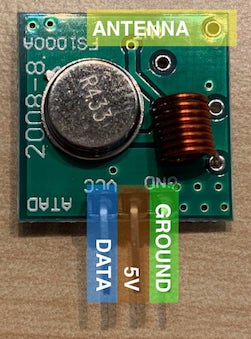Turning a Raspberry Pi into a LightwaveRF hub.
This allows the Pi to partially emulate a first-generation LightwaveRF hub. Essentially it takes UDP traffic and turns it into 433Mhz signals to the devices, allowing you to replace the Hub. The major goal with to get it working with Homebridge via the LightwaveRF plugin.
This is very much in debt to Robert Tidey's LightwaveRF work, and uses his transmission logic.
- It only supports the dimmable light switches, as that's all I have to use or test with.
- It doesn't support any over-internet functionality (e.g. the LightwaveRF app or the Alexa integration), as that depends on server-side functionality. However, the use of Homebridge to expose it to Apple's Homekit works around this for my use case.
- A 433Mhz transmitter module
- 3 x Female-to-female jumper cables
- A Raspberry Pi, in my case a 3B+.
Given the GPIO port:
- Data to pin 12 (GPIO18)
- 5V to pin 1 (5V)
- Ground to pin 3 (Ground)
It's also worth adding on an antenna to the board - 170mm of wire should be about a quarter-wavelength.
-
Rasbpian 10.3 (in this case, shouldn't be particularly tied to it)
-
Python 3
sudo apt install python3
-
sudo apt install pigpio sudo systemctl enable pigpiod sudo systemctl start pigpiod
Firstly, you'll need to set up your device mappings. This maps from the names used by the UDP protocol to the IDs used by the radio protocol. To do this we use a YAML file in a subset of the format used by Paul Clarke's popular LightwaveRF Gem.
room:
- name: A Room
device:
- name: Telly Lights
id: D7
- name: Door Lights
id: D2
- name: Another Room
device:
- name: LightsThe IDs of the rooms and devices will be determined by the id attribute (only the numeric part will be used), or the index within the list if no id is present. e.g. A Room/Telly Lights would be room_id=1 and device_id=7. Another Room/Lights would be room_id=2 and device_id=1.
You can have up to 8 rooms, and up to 15 devices per room. The protocol allows for more rooms, but I believe this matches the limits imposed by the app.
pip install -r requirements.txt
pywaverf/main.py --help # show usage infoYou'll need to ensure your devices are paired, or they'll ignore the messages from the hub. Make sure the device is in pairing mode before doing so, or the message will have no effect.
pywaverf/main.py pair --room 'A Room' --device 'Door Lights'Once paired, you can test by sending messages directly:
pywaverf/main.py on --room 'Another Room' --device 'Lights' # turn a paired unit on
pywaverf/main.py off --room 'Another Room' --device 'Lights' # and off againYou can finally start the listener for UDP messages:
pywaverf/main.py listenYou can then send test messages with the LightwaveRF Gem, or via netcat:
echo '666,!R1D5F1|ignored|ignored' | nc -w 1 -u <address-of-listening-host> 9760 # turn room 1 device 5 on
echo '666,!R1D5F0|ignored|ignored' | nc -w 1 -u <address-of-listening-host> 9760 # turn room 1 device 5 offOnce you have the pairing and the mappings file in place, you can install the listening daemon via the Makefile. This will run it via Systemd, and will install the required Python packages to your system environment.
sudo make install
sudo systemctl start piwaverf